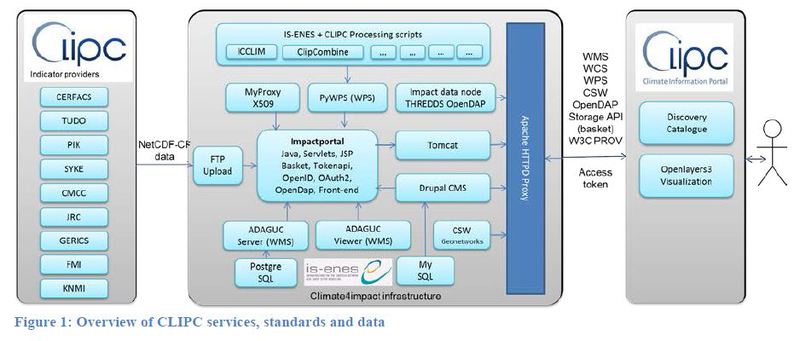D4.4 Integrated toolbox report
The CLIPC architecture has been build using Open Standards to provide well defined interfaces between data, service back-end and the end user portal. Data is provided in standardized NetCDF-CF format. This enables easy integration into the back-end services. The back-end services are provided to a front-end portal, enabling the CLIPC toolkit functions: Compare, Combine, Calculate indices and MyCLIPC.
The Compare functionality is provided by the ADAGUCADAGUC
Atmospheric data access for the geospatial user community. Read more on the ADAGUC Website. WMSWMS
Web Mapping Service service, which is capable to automatically generate a WMS service on NetCDF-CF data.

The Combine functionality is a co-development with WP8. In the combine function two maps can be normalized and combined, using a combine function. At this moment 3 different normalization functions (none, min/max, Z-score) and 8 combine functions (Add, Subtract, Multiply, Divide, Multiply, Less, Equal, Greater) are provided. Besides the result, also the provenance metadatametadata
Information about meteorological and climatological data concerning how and when they were measured, their quality, known problems and other characteristics. is stored in the resulting NetCDF-CF file. The combine function uses the WCS and WPSWPS
OGC Web Processing Service standards for implementation.
Calculate indices is provided by using indices calculations functions from ICCLIM, using pyWPS as implementation for the WPS standard. For processing services a caching system was developed and tested.
MyCLIPC enables users to store, combine and calculate results and to check on longer running processes. The user simply logs in using a Google account. This functionality is provided using the StorageAPI of Climate4Impact.
All is secured using Public Key Infrastructure (PKI), OpenIDOpenID
OpenID is an open standard that describes how users can be authenicated in a decentralized manner, eliminating the need for services to provide their own ad hoc systems and allowing the users to consolidate their digital identities. [Source: WikiPedia] and OAUTH2.
The data and backend services are hosted at KNMI in the Climate4Impact portal and in the ESGFESGF
The Earth System Grid Federation (ESGF) is an international collaboration with a current focus on serving the World Climate Research Programme (WCRP) Coupled Model Intercomparison Project (CMIP) and supporting climate and environmental science in general. The ESGF grew out of the larger Global Organization for Earth System Science Portals (GO-ESSP) community, and reflects a broad array of contributions from the collaborating partners. network. The CLIPC front-end portal is hosted and operated by MARIS, at a different location.
The use of Climate4Impact services and expanding on this framework enabled CLIPC to have a head start and a proven platform for development. The services can easily be expanded to provide new and improved services. Next steps include expanding the Combine services with compatibility guidance for the creation of sensible combinations (or issue a warning). A skeleton WPS has already been made available for this purpose.
Download the document here